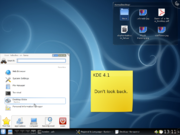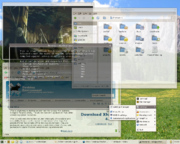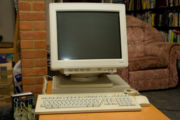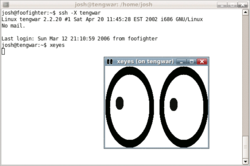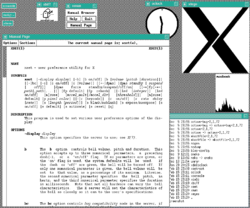X Window System
2008/9 Schools Wikipedia Selection. Related subjects: Software
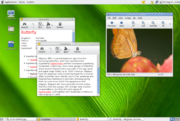
In computing, the X Window System (commonly X11 or X) is a windowing system which implements the X display protocol and provides windowing on bitmap displays. It provides the standard toolkit and protocol with which to build graphical user interfaces (GUIs) on most Unix-like operating systems and OpenVMS, and has been ported to many other contemporary general purpose operating systems.
X provides the basic framework, or primitives, for building GUI environments: drawing and moving windows on the screen and interacting with a mouse and/or keyboard. X does not mandate the user interface — individual client programs handle this. As such, the visual styling of X-based environments varies greatly; different programs may present radically different interfaces. X is built as an additional application layer on top of the operating system kernel.
Unlike previous display protocols, X was specifically designed to be used over network connections rather than on an integral or attached display device. X features network transparency: the machine where an application program (the client application) runs can differ from the user's local machine (the display server).
X originated at MIT in 1984. The current protocol version, X11, appeared in September 1987. The X.Org Foundation leads the X project, with the current reference implementation, X.org Server, available as free software under the MIT License and similar permissive licences.
Design
X uses a client-server model: an X server communicates with various client programs. The server accepts requests for graphical output (windows) and sends back user input (from keyboard, mouse, or touchscreen). The server may function as:
- an application displaying to a window of another display system
- a system program controlling the video output of a PC
- a dedicated piece of hardware.
This client-server terminology — the user's terminal as the "server", the remote or local applications as the "clients" — often confuses new X users, because the terms appear reversed. But X takes the perspective of the program, rather than that of the end-user or of the hardware: the local X display provides display services to programs, so it acts as a server; any remote program uses these services, thus it acts as a client.
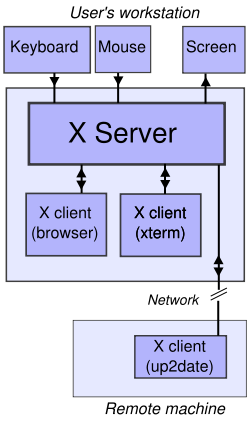
The communication protocol between server and client operates network-transparently: the client and server may run on the same machine or on different ones, possibly with different architectures and operating systems, but they run the same in either case. A client and server can even communicate securely over the Internet by tunneling the connection over an encrypted network session.
An X client itself may contain an X server having display of multiple clients. This is known as "X nesting". Open-source clients such as Xnest and Xephyr support such X nesting.
To start a remote client program displaying to a local server, the user will typically open a terminal window and telnet or ssh to the remote client application or shell and request local display/input service (e.g. export DISPLAY=[user's machine]:0 on a remote machine running bash). The client application or shell then connects to the local server, servicing a display and input session to the local user. Alternatively, the local machine may run a small helper program to connect to a remote machine and start the desired client application there.
Practical examples of remote clients include:
- administering a remote machine graphically
- running a computationally intensive simulation on a remote Unix machine and displaying the results on a local Windows desktop machine
- running graphical software on several machines at once, controlled by a single display, keyboard and mouse.
Principles
In 1984, Bob Scheifler and Jim Gettys set out the early principles of X:
- Do not add new functionality unless an implementor cannot complete a real application without it.
- It is as important to decide what a system is not as to decide what it is. Do not serve all the world's needs; rather, make the system extensible so that additional needs can be met in an upwardly compatible fashion.
- The only thing worse than generalizing from one example is generalizing from no examples at all.
- If a problem is not completely understood, it is probably best to provide no solution at all.
- If you can get 90 percent of the desired effect for 10 percent of the work, use the simpler solution. (See also Worse is better.)
- Isolate complexity as much as possible.
- Provide mechanism rather than policy. In particular, place user interface policy in the clients' hands.
The first principle was modified during the design of X11 to: "Do not add new functionality unless you know of some real application that will require it."
X has largely kept to these principles since. The reference implementation is developed with a view to extension and improvement of the implementation, whilst remaining almost entirely compatible with the original 1987 protocol.
User interfaces
X deliberately contains no specification as to application user interface, such as buttons, menus, window title bars and so on. Instead, user software – such as window managers, GUI widget toolkits and desktop environments, or application-specific graphical user interfaces – provide/define all such details. As such, it isn't possible to point to a "typical" X interface as at most times several interfaces have been popular among users.
A window manager controls the placement and appearance of application windows. This may have an interface akin to that of Microsoft Windows or of the Macintosh (examples include Metacity in GNOME, KWin in KDE or Xfwm in Xfce) or have radically different controls (such as a tiling window manager). The window manager may be bare-bones (e.g. twm, the basic window manager supplied with X, or evilwm, an extremely light window manager) or offer functionality verging on that of a full desktop environment (e.g. Enlightenment).
Many users use X with a full desktop environment, which includes a window manager, various applications and a consistent interface. GNOME, KDE and Xfce are the most popular desktop environments. The Unix standard environment is the Common Desktop Environment (CDE). The freedesktop.org initiative addresses interoperability between desktops and the components needed for a competitive X desktop.
As X is responsible for keyboard and mouse interaction with graphical desktops, certain keyboard shortcuts have become associated with X. Control-Alt-Backspace typically terminates the currently running X session, while Control-Alt in conjunction with a function key switches to the associated virtual console. Note, however, that this is an implementation detail left to an individual X server and is by no means universal; for example, X server implementations for Windows and Macintosh typically do not provide these shortcuts.
Implementations
The X.Org reference implementation serves as the canonical implementation of X. Due to liberal licensing, a number of variations, both free and proprietary, have appeared. Commercial UNIX vendors have tended to take the reference implementation and adapt it for their hardware, usually customising it heavily and adding proprietary extensions.
|
|
Up to 2004, XFree86 provided the most common X variant on free Unix-like systems. XFree86 started as a port of X for 386-compatible PCs and, by the end of the 1990s, had become the greatest source of technical innovation in X and the de facto standard of X development. Since 2004, however, the X.Org reference implementation, a fork of XFree86, has become predominant.
While computer aficionados most often associate X with Unix, X servers also exist natively within other graphical environments. Hewlett-Packard's OpenVMS operating system includes a version of X with CDE, known as DECwindows, as its standard desktop environment. Apple's Mac OS X v10.3 (Panther) and up includes X11.app, based on XFree86 4.3 and X11R6.6, with better Mac OS X integration. Third-party servers under Mac OS 7, 8 and 9 included MacX.
Microsoft Windows does not come with support for X, but many third-party implementations exist, both free software such as Cygwin/X, Xming and WeirdX; and proprietary products such as Xmanager, MKS X/Server, Exceed and X-Win32. They normally serve to control remote X clients.
When another windowing system (such as those of Microsoft Windows or Mac OS) hosts X, the X system generally runs "rootless", meaning the host windowing environment looks after the root window (the background and associated menus) and manages the geometry of the hosted X windows — although some servers (Xmanager, and Exceed, for example) can also create the root window for the remote clients to display to as a separate window in the host system.
X terminals
An X terminal is a thin client that runs an X server. This architecture became popular for building inexpensive terminal parks for many users to simultaneously use the same large server (making programs being run on the server clients of the X terminal). This use very much aligns with the original intention of the MIT project.
X terminals explore the network (the local broadcast domain) using the X Display Manager Control Protocol to generate a list of available hosts that they can run clients from. The initial host needs to run an X display manager.
Dedicated (hardware) X terminals have become less common; a PC or modern thin client with an X server typically provides the same functionality at the same, or lower, cost.
User interface features
X deliberately contains no specification as to user interface or most inter-application communication. This has resulted in several vastly different interfaces, and in applications that have not always worked well together. The ICCCM, a specification for client interoperability, has a reputation as difficult to implement correctly. Further standards efforts such as Motif and CDE did not remedy matters. This has frustrated users and programmers for a long time. Graphics programmers now generally address consistency of application look and feel and communication by coding to a specific desktop environment or to a specific widget toolkit, which also avoids having to deal directly with the ICCCM.
The X protocol provides no facilities for handling audio, leaving it to the operating system or audio systems like OSS or ALSA to provide support for audio hardware and sound playback. Most programmers simply use local, OS-specific sound APIs. The first generation of client-server sound systems included rplay and Network Audio System. More recent efforts have produced EsounD (GNOME), aRts (KDE), and PulseAudio to name a few. In 2001, the X.org foundation announced the development of the Media Application Server (MAS) to remedy this problem. However, none of these are generally used as a solution to the problem.
Network
An X client cannot generally be detached from one server and reattached to another, as with Virtual Network Computing (VNC), though certain specific applications and toolkits are able to provide this facility. Workarounds (VNC :0 viewers) also exist to make the current X-server screen available via VNC.
Network traffic between an X server and remote X clients is not encrypted by default. An attacker with a packet sniffer can intercept it, making it possible to view anything displayed to or sent from the user's screen. The most common way to encrypt X traffic is to tunnel it over SSH.
Client-server separation
X's design requires the clients and server to operate separately, and device independence and the separation of client and server incur overhead compared to an operating system where the graphics are integrated into the OS, such as early versions of Microsoft Windows or Mac OS. X advocates recommended 4 to 8 MB of RAM for reasonable performance; until the mid-1990s, this seemed bloated compared to Windows or Mac OS.
Current versions of Windows and Mac OS X Quartz have internal subsystem separation similar to the client/server divide in X and comparable performance and higher resource usage to X with GNOME or KDE. Most of the overhead comes from network round-trip delay time between client and server ( latency rather than from the protocol itself): the best solutions to performance issues involve paying attention to application design. A common criticism of X is that its network features result in excessive complexity and decreased performance if only used locally. That used to be the case, but modern X implementations are able to use unix domain sockets and shared memory (the MIT-SHM extension) to work around the network overhead. The programmer must still explicitly activate and use those extensions in order to improve performance and must also provide fallback paths in order to stay compatible with older implementations.
Competitors to X
For graphics, Unix-like systems use X almost universally. However, some people have attempted writing alternatives to and replacements for X. Historical alternatives include Sun's NeWS, which failed in the market, and NeXT's Display PostScript, which was discarded in favour of Apple's entirely new Quartz in Mac OS X.
Mike Paquette, one of the authors of Quartz, explained why Apple did not move from Display PostScript to X, and chose instead to develop its own window server, by saying that once Apple added support for all the features it wanted to include in to X11, it would not bear much resemblance to X11 nor be compatible with other servers anyway.
Other attempts to address criticisms of X by replacing it completely include Berlin/ Fresco and the Y Window System. These alternatives have seen negligible take-up, however, and commentators widely doubt the viability of any replacement that does not preserve backward compatibility with X.
Other competitors attempt to avoid the overhead of X by working directly with the hardware. Such projects include DirectFB and the very small FBUI. The Direct Rendering Infrastructure (DRI), which aims to provide a reliable kernel-level interface to the framebuffer, may make these efforts redundant. However, in Linux embedded systems requiring real-time capabilities (e.g. using RTAI), the use of hardware acceleration via DRI is discouraged; X may be unsuitable for such applications.
Other ways to achieve network transparency for graphical services include:
- the SVG Terminal, a protocol to update Scalable Vector Graphics (SVG) content in a browser in near-real-time
- Virtual Network Computing (VNC), a very low-level system which sends compressed bitmaps across the network; the Unix implementation includes an X server
- Citrix XenApp, an X-like product for Microsoft Windows
- Tarantella, which provides a Java client for use in web browsers
- RAWT, IBM's Java-only Remote AWT, which implements a Java "server" and simple hooks for any remote Java client
History
Predecessors
Several bitmap display systems preceded X. From Xerox came the Alto (1973) and the Star (1981). From Apple came the Lisa (1983) and the Macintosh (1984). The Unix world had the Andrew Project (1982) and Rob Pike's Blit terminal (1982).
X derives its name as a successor to a pre-1983 window system called W (the letter X directly following W in the Latin alphabet). W Window System ran under the V operating system. W used a network protocol supporting terminal and graphics windows, the server maintaining display lists.
Origin and early development
The original idea of X emerged at MIT in 1984 as a collaboration between Jim Gettys (of Project Athena) and Bob Scheifler (of the MIT Laboratory for Computer Science). Scheifler needed a usable display environment for debugging the Argus system. Project Athena (a joint project between Digital Equipment Corporation (DEC), MIT and IBM to provide easy access to computing resources for all students) needed a platform-independent graphics system to link together its heterogeneous multiple-vendor systems; the window system then under development in Carnegie Mellon University's Andrew Project did not make licenses available, and no alternatives existed.
The project solved this by creating a protocol that could both run local applications and call on remote resources. In mid-1983 an initial port of W to Unix ran at one-fifth of its speed under V; in May 1984, Scheifler replaced the synchronous protocol of W with an asynchronous protocol and the display lists with immediate mode graphics to make X version 1. X became the first windowing system environment to offer true hardware-independence and vendor-independence.
Scheifler, Gettys and Ron Newman set to work and X progressed rapidly. They released Version 6 in January 1985. DEC, then preparing to release its first Ultrix workstation, judged X the only windowing system likely to become available in time. DEC engineers ported X6 to DEC's QVSS display on MicroVAX.
In the second quarter of 1985 X acquired colour support to function in the DEC VAXstation-II/GPX, forming what became version 9.
A group at Brown University ported version 9 to the IBM RT/PC, but problems with reading unaligned data on the RT forced an incompatible protocol change, leading to version 10 in late 1985. By 1986, outside organizations had started asking for X. The release of X10R2 took place in January 1986; that of X10R3 in February 1986. Although MIT had licensed X6 to some outside groups for a fee, it decided at this time to license X10R3 and future versions under what became known as the MIT License, intending to popularize X further and in return, hoping that many more applications would become available. X10R3 became the first version to achieve wide deployment, with both DEC and Hewlett-Packard releasing products based on it. Other groups ported X10 to Apollo and to Sun workstations and even to the IBM PC/AT. Demonstrations of the first commercial application for X (a mechanical computer-aided engineering system from Cognition Inc. that ran on VAXes and displayed on PCs running an X server) took place at the Autofact trade show at that time. The last version of X10, X10R4, appeared in December 1986.
Attempts were made to enable X servers as real-time collaboration devices, much as Virtual Network Computing (VNC) would later allow a desktop to be shared. One such early effort was Philip J. Gust's SharedX tool.
Although X10 offered interesting and powerful functionality, it had become obvious that the X protocol could use a more hardware-neutral redesign before it became too widely deployed; but MIT alone would not have the resources available for such a complete redesign. As it happened, DEC's Western Software Laboratory found itself between projects with an experienced team. Smokey Wallace of DEC WSL and Jim Gettys proposed that DEC WSL build X11 and make it freely available under the same terms as X9 and X10. This process started in May 1986, with the protocol finalized in August. Alpha-testing of the software started in February 1987, beta-testing in May; the release of X11 finally occurred on September 15, 1987.
The X11 protocol design, led by Scheifler, was extensively discussed on open mailing lists on the nascent Internet that were bridged to USENET newsgroups. Gettys moved to California to help lead the X11 development work at WSL from DEC's Systems Research Centre, where Phil Karlton and Susan Angebrandt led the X11 sample server design and implementation. X therefore represents one of the first very large-scale distributed free software projects.
The MIT X Consortium and the X Consortium, Inc.
In 1987, with the success of X11 becoming apparent, MIT wished to relinquish the stewardship of X, but at a June 1987 meeting with nine vendors, the vendors told MIT that they believed in the need for a neutral party to keep X from fragmenting in the marketplace. In January 1988, the MIT X Consortium formed as a non-profit vendor group, with Scheifler as director, to direct the future development of X in a neutral atmosphere inclusive of commercial and educational interests. Jim Fulton joined in January 1988 and Keith Packard in March 1988 as senior developers, with Jim focusing on Xlib, fonts, window managers, and utilities; and Keith re-implementing the server. Donna Converse and Chris D. Peterson joined later that year, focusing on toolkits and widget sets, working closely with Ralph Swick of MIT Project Athena. The MIT X Consortium produced several significant revisions to X11, the first (Release 2 - X11R2) in February 1988.
|
|
In 1993, the X Consortium, Inc. (a non-profit corporation) formed as the successor to the MIT X Consortium. It released X11R6 on May 16, 1994. In 1995 it took over stewardship of the Motif toolkit and of the Common Desktop Environment for Unix systems. The X Consortium dissolved at the end of 1996, producing a final revision, X11R6.3, and a legacy of increasing commercial influence in the development.
The Open Group
In mid-1997 the X Consortium passed stewardship of X to The Open Group, a vendor group formed in early 1996 by the merger of the Open Software Foundation and X/Open.
The Open Group released X11R6.4 in early 1998. Controversially, X11R6.4 departed from the traditional liberal licensing terms, as the Open Group sought to assure funding for X's development. The new terms would have prevented its adoption by many projects (such as XFree86) and even by some commercial vendors. After XFree86 seemed poised to fork, the Open Group relicensed X11R6.4 under the traditional license in September 1998. The Open Group's last release came as X11R6.4 patch 3.
X.Org and XFree86
XFree86 originated in 1992 from the X386 server for IBM PC compatibles included with X11R5 in 1991, written by Thomas Roell and Mark W. Snitily and donated to the MIT X Consortium by Snitily Graphics Consulting Services (SGCS). XFree86 evolved over time from just one port of X to the leading and most popular implementation and the de facto steward of X's development.
In May 1999, the Open Group formed X.Org. X.Org supervised the release of versions X11R6.5.1 onward. X development at this time had become moribund; most technical innovation since the X Consortium had dissolved had taken place in the XFree86 project. In 1999, the XFree86 team joined X.Org as an honorary (non-paying) member, encouraged by various hardware companies interested in using XFree86 with Linux and in its status as the most popular version of X.
By 2003, while the popularity of Linux (and hence the installed base of X) surged, X.Org remained inactive, and active development took place largely within XFree86. However, considerable dissent developed within XFree86. The XFree86 project suffered from a perception of a far too cathedral-like development model; developers could not get CVS commit access and vendors had to maintain extensive patch sets. In March 2003 the XFree86 organization expelled Keith Packard, who had joined XFree86 after the end of the original MIT X Consortium, with considerable ill-feeling.
X.Org and XFree86 began discussing a reorganisation suited to properly nurturing the development of X. Jim Gettys had been pushing strongly for an open development model since at least 2000. Gettys, Packard and several others began discussing in detail the requirements for the effective governance of X with open development.
Finally, in an echo of the X11R6.4 licensing dispute, XFree86 released version 4.4 in February 2004 under a more restricted license which many projects relying on X found unacceptable. The added clause to the license was based upon the original BSD license's advertising clause, which was viewed by the Free Software Foundation and Debian as incompatible with the GNU General Public License. Other groups saw further restrictions as being against the spirit of the original X (OpenBSD threatening a fork, for example). The license issue, combined with the difficulties in getting changes in, left many feeling the time was ripe for a fork.
The X.Org Foundation
In early 2004 various people from X.Org and freedesktop.org formed the X.Org Foundation, and the Open Group gave it control of the x.org domain name. This marked a radical change in the governance of X. Whereas the stewards of X since 1988 (including the previous X.Org) had been vendor organizations, the Foundation was led by software developers and used community development based on the bazaar model, which relies on outside involvement. Membership was opened to individuals, with corporate membership being in the form of sponsorship. Several major corporations such as Hewlett-Packard and Sun Microsystems currently support the X.Org Foundation.
The Foundation takes an oversight role over X development: technical decisions are made on their merits by achieving rough consensus among community members. Technical decisions are not made by the board of directors; in this sense, it is strongly modelled on the technically non-interventionist GNOME Foundation. The Foundation does not employ any developers.
The Foundation released X11R6.7, the X.Org Server, in April 2004, based on XFree86 4.4RC2 with X11R6.6 changes merged. Gettys and Packard had taken the last version of XFree86 under the old license and, by making a point of an open development model and retaining GPL compatibility, brought many of the old XFree86 developers on board.
X11R6.8 came out in September 2004. It added significant new features, including preliminary support for translucent windows and other sophisticated visual effects, screen magnifiers and thumbnailers, and facilities to integrate with 3D immersive display systems such as Sun's Project Looking Glass and the Croquet project. External applications called compositing window managers provide policy for the visual appearance.
On December 21, 2005 , X.Org released X11R6.9, the monolithic source tree for legacy users, and X11R7.0, the same source code separated into independent modules, each maintainable in separate projects. The Foundation released X11R7.1 on May 22, 2006, about four months after 7.0, with considerable feature improvements.
Future directions
With the X.Org Foundation and freedesktop.org, the main line of X development has started to progress rapidly once more. The developers intend to release present and future versions as usable finished products, not merely as bases for vendors to build a product upon.
For sufficiently capable combinations of hardware and operating systems, X.Org plans to access the video hardware only via OpenGL and the Direct Rendering Infrastructure (DRI). The DRI first appeared in XFree86 version 4.0 and became standard in X11R6.7 and later. Many operating systems have started to add kernel support for hardware manipulation. This work proceeds incrementally.
Nomenclature
People in the computer trade commonly shorten the phrase "X Window System" to "X11" or simply to "X". The term "X Windows" (in the manner of "Microsoft Windows") is not officially endorsed, though it has been in common use since early in the history of X and has been used deliberately for literary effect, for example in the UNIX-HATERS Handbook.
Release history
| Version | Release date | Most important changes |
|---|---|---|
| X1 | June 1984 | First use of the name "X"; fundamental changes distinguishing the product from W. |
| X6 | January 1985 | First version licensed to a handful of outside companies. |
| X9 | September 1985 | Colour. First release under MIT License. |
| X10 | late 1985 | IBM RT/PC, AT (running DOS), and others |
| X10R2 | January 1986 | |
| X10R3 | February 1986 | First release outside MIT. uwm made standard window manager. |
| X10R4 | December 1986 | Last version of X10. |
| X11 | September 15, 1987 | First release of the current protocol. |
| X11R2 | February 1988 | First X Consortium release. |
| X11R3 | October 25, 1988 | XDM |
| X11R4 | December 22, 1989 | XDMCP, twm brought in as standard window manager, application improvements, Shape extension, new fonts. |
| X11R4/X11R5 | December 1989 | Commodore sells the Amiga 2500/UX (Unix based). It was the first computer sold on the market featuring standard X11 based desktop GUI called Open Look. Running AT&T UNIX System V R4, the system was equipped with 68020 or 68030 CPU accelerator card, SCSI controller card, Texas Instruments TIGA 24bit graphic card capable to show 256 colors on screen, and a three buttons mouse. |
| X11R5 | September 5, 1991 | PEX, Xcms ( colour management), font server, X386, X video extension |
| X11R6 | May 16, 1994 | ICCCM v2.0; Inter-Client Exchange; X Session Management; X Synchronization extension; X Image extension; XTEST extension; X Input; X Big Requests; XC-MISC; XFree86 changes. |
| X11R6.1 | March 14, 1996 | X Double Buffer extension; X keyboard extension; X Record extension. |
| X11R6.2 X11R6.3 (Broadway) |
December 23, 1996 | Web functionality, LBX. Last X Consortium release. X11R6.2 is the tag for a subset of X11R6.3 with the only new features over R6.1 being XPrint and the Xlib implementation of vertical writing and user-defined character support. |
| X11R6.4 | March 31, 1998 | Xinerama. |
| X11R6.5 | Internal X.org release; not made publicly available. | |
| X11R6.5.1 | August 20, 2000 | |
| X11R6.6 | April 4, 2001 | Bug fixes, XFree86 changes. |
| X11R6.7.0 | April 6, 2004 | First X.Org Foundation release, incorporating XFree86 4.4rc2. Full end-user distribution. Removal of XIE, PEX and libxml2. |
| X11R6.8.0 | September 8, 2004 | Window translucency, XDamage, Distributed Multihead X, XFixes, Composite, XEvIE. |
| X11R6.8.1 | September 17, 2004 | Security fix in libxpm. |
| X11R6.8.2 | February 10, 2005 | Bug fixes, driver updates. |
| X11R6.9 X11R7.0 |
December 21, 2005 | EXA, major source code refactoring. From the same source-code base, the modular autotooled version became 7.0 and the monolithic imake version was frozen at 6.9. |
| X11R7.1 | May 22, 2006 | EXA enhancements, KDrive integrated, AIGLX, OS and platform support enhancements. |
| X11R7.2 | February 15, 2007 | Removal of LBX and the built-in keyboard driver, X-ACE, XCB, autoconfig improvements, cleanups. |
| X11R7.3 | September 6, 2007 | XServer 1.4, Input hotplug, output hotplug ( RandR 1.2), DTrace probes, PCI domain support. |
Forthcoming releases
| Version | Release date | Most important changes |
|---|---|---|
| X11R7.4 | XServer 1.5, XACE, pci-rework, _X_EXPORT, DRI memory manager, GLX 1.4 | |
| X11R7.5 | XKB 2 and Xi 2, XGE, RandR 1.3 (GPU object), input transformation, Glucose , MPX, Removal of obsolete libraries and extensions. |
